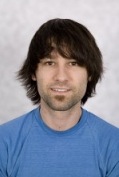Team:Cambridge/Society/interviews
From 2011.igem.org
Background
On our online questionnaire, participants were asked if they were willing to be contacted with some further questions about their iGEM experience and their subsequent careers. It was good to see that a large proportion of our survey participants answered in the affirmative to this.
Four respondents were contacted. Two (Shuna Gould and Justin Pahara) were working in Cambridge and were willing to drop by the lab for a filmed interview. Kim de Mora was in Edinburgh and recorded via skype. Joel Grim was working in the U.S. and contacted via Google Chat.
The impact of iGEM – an interview with Justin Pahara
Justin Pahara was first involved in iGEM shortly after finishing his first degree in Immunology and Infection. He met Andrew Hessle, who he describes as an evangelist for Synthetic Biology. Through this meeting Justin was introduced to synthetic biology which not only changed his views, but lead him to cross the globe, pursue a PHD in biotechnology and found several start up companies including one orientated towards catalysing interdisciplinary work in synthetic biology.
In 2007, Justin was part of Andrew Hessle’s Alberta University team as iGEM was brought to Canada for the first time. The team focussed on engineering biobutanol production, as they believed it could be a biofuel superior to bioethanol, hence their slogan “save the ethanol for drinking”. In 2008 Justin was also an iGEM advisor on the 2008 team.
We asked Justin if iGEM changed the kind of people you expected to work with? With some conviction he told us the iGEM most definitely had; he is now a strong advocate of interdisciplinary work having seen the benefits that can come from bringing expertise from artists, businesspeople, and engineers together to push science forward. He stressed that the solution to a problem will often be better when found in conjunction with a team from diverse backgrounds than when limited to colleagues in your own academic circle. A step outside the scientific comfort zone, he says.
Perhaps one of the biggest influences on an alumnus iGEM could ever have is convincing them that they could make a living in synthetic biology. This is what iGEM has done for Justin Pahara. His company Synbiota, founded with colleagues who work in bioinformatics and software development, will provide tools and services to enable and equip scientists, particularly those in synthetic biology, with a grand aim of making a web of information and idea sharing which they hope will improve the productivity of the field from grass-roots school projects to field leaders.
We probed him to find out how much of iGEM had rubbed off on him and his business ventures. He replied that Synbiota is adhering to synthetic biology principles. They agree with abstraction as a valuable process by which to remove unnecessary complexity and strongly support crowd-sourcing of information as an engine with which to power progress. Justin firmly believes that it is only a matter of time until the rest of the world adopts these principles in broader contexts.
Justin claims that he would always have headed into biotechnology to make his name, but that iGEM resulted in a profound change in his ideas about science and engineering. Although he believes he would have realised the benefits of concepts such as abstraction and crowd-sourcing eventually, he feels he has had a head-start on colleagues working in biotech as a direct result of his involvement in iGEM and being introduced to synthetic biology. For Justin, the most important thing he learnt was the parallels that can be drawn between synthetic biology and the software industry as markets.
In particular Justin envisages a future where the cost of DNA synthesis comes down to the point where, like when the personal computer entered peoples homes, making DNA will be not only relatively quick and cheap, but a technology with a rapidly growing user base. In fact he predicts that the design and ‘light tinkering’ of DNA is a field that will literally explode. He paints an inspiring picture one of DNA modification by those in academia, corporations, DIY bio, even junior high school kids will be just chilling out, writing DNA code.
Questions by Cambridge iGEM 2011 Team, Interview by Joe Harvey, Write-up by Matt Jones.
 "
"



